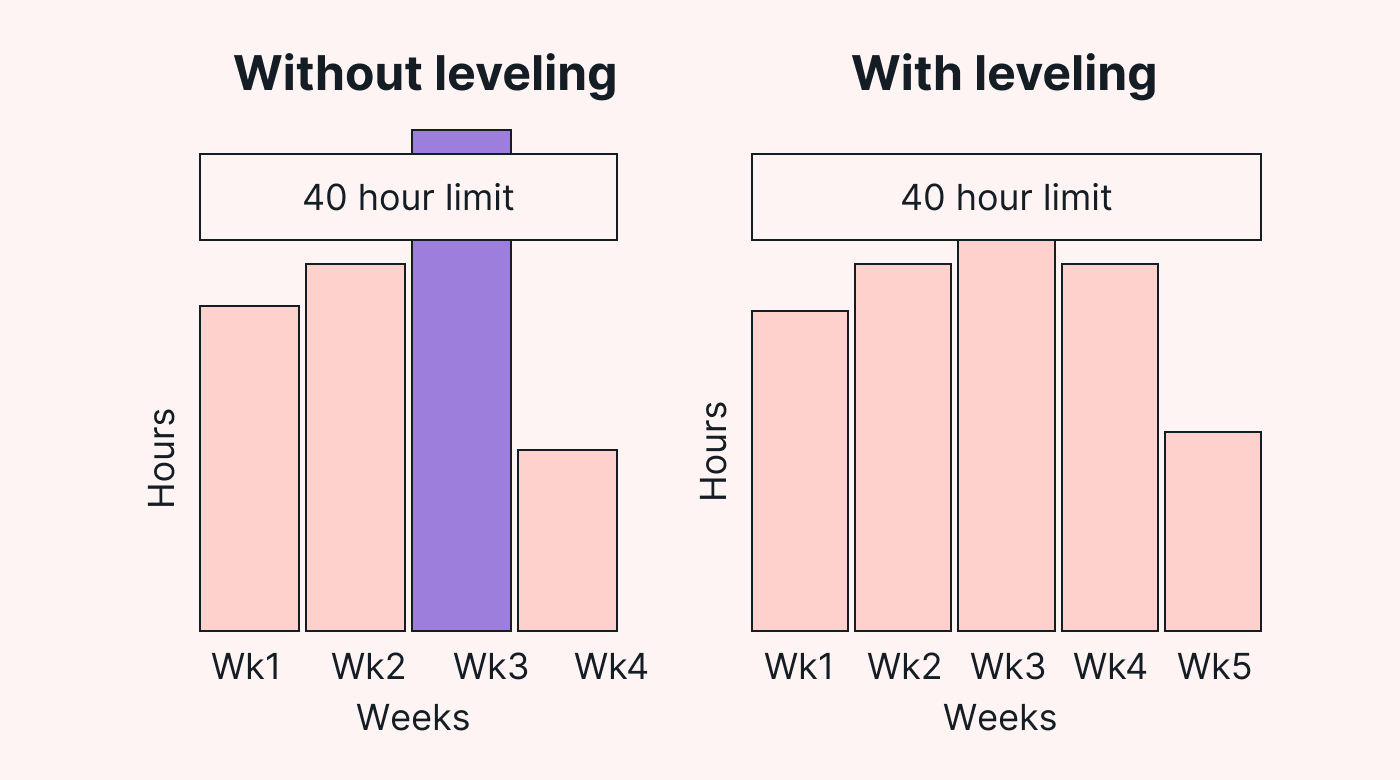Whether you’re running a project or a business, making the most of what you have is the key to your efficiency and cost-effectiveness. This is where constructive resource allocation can help you. It guides you in assigning the right people, with the right tools, funding, and expertise, to the tasks that maximize your opportunities.
Allocating your resources correctly can prevent deadline slippages and ensure you don’t load too much work on your tried-and-tested team members — which is always a temptation. But opportunities often come with challenges, and effective resource planning helps you navigate these stormy seas.
Resource planning helps you manage resource capacities, identify and mitigate risks, optimize the use of your resources, and determine realistic deadlines. Properly planning the allocation of resources also helps you make more effective use of shared resources, maximize the availability of resources, and deal with unexpected problems.
What are resources?
To properly understand resource allocation, we first need to understand what a resource is. There are many kinds of resources on which you can call during a project, but they usually will fall into one of three categories.
Human resources
To all intents and purposes, the human resource (HR) challenges faced by small businesses and on projects are identical. A limited resource pool in terms of people and skills characterizes both environments. So making the most of what you have can require careful consideration.
This challenge is particularly difficult when it comes to rare specialist skills, which need to be maximized, but without exhausting or unduly taxing the individuals with those skills. Getting that balance right is an exercise in efficient resource allocation that, if done correctly, may just grow the size of your pool of available skills the next time around.
Material resources
Of course, resources in a business and on a project aren’t limited to people. You must also consider the allocation of equipment, raw materials, and consumables needed to complete the required work successfully.
Of particular concern here is that you have resource availability when it’s required to perform a given job on a project or a production line. Not planning for this properly could compromise the production line or put the entire project at risk. Either outcome carries costs, sometimes very significant ones.
Financial resources
Speaking of costs, in any small business or on any project, the budget is king. Constrained financial resources have killed off more than one enterprise over the years, and you don’t want that nasty fate to befall yours.
 |
That being the case, you need to be absolutely certain that the funding committed to the venture is adequate for all the tasks at hand. It must also have a little wiggle room to handle unforeseen events, and it simply can’t suddenly evaporate when priorities change. Down that road can lie serious reputational damage.
What is resource allocation?
There’s one single principle that describes resource allocation. It is to balance competing needs and priorities and find the best way to maximize your limited resources while deriving the greatest return on investment.
How to do resource allocation effectively?
The easiest way to describe the process mentioned above is as a juggling act. The bigger the business or project, the more balls you’ll have in the air at any time — and you can’t afford to drop any of them.
The secret is to pass as many of those balls to other people as possible, even if it’s just to give you the capacity to handle those coming back in your direction. And although it sounds chaotic, you can control it in a structured way.
Understand your goals
If you don’t know where you want to go, you’re not going to get there. Whether you’re running a business or a project, you have to identify and set achievable project objectives because, if you don’t, you’re setting yourself up for failure.
But it can be difficult because, sometimes, the job just seems enormous. So the way to tackle it is the same way you’d eat an elephant: one bite at a time. Break down your big job into smaller, much more manageable chunks.
Assess available resources
Having done that, you now need to identify what resources are going to be available to you for this business or project. Then, looking at those chunks, you’d need to figure out where you might encounter shortfalls in human, material, or financial resources.
Clearly, your team won’t complete some chunks unless you supplement the available resources. You’ll need to look at hiring specialist skills or equipment to do that. You may need to acquire additional tools or raw materials or secure additional funding.
Identify scheduling and resource dependencies
Now, you’re able to look at each chunk and decide which of the available resources are needed to complete it successfully. You also need to look at the sequence of events because it is quite likely that task dependencies exist where particular jobs must be carried out in a particular order.
It can complicate things if two or more tasks that are planned to run at the same time are going to need some of the same resources (machinery, tools, or humans). You may again find that you have a resource shortfall and have two options: reschedule one or more of the tasks or bring in more of the required resources.
Consider the budget
By this stage, you’ll already have a good appreciation of your funding needs in the business or on the project, whichever may be the case. Now you must dig in to make sure that the financial resources you’ll need have been committed.
Always remember that financial resources are the lifeblood of any business or project and a massive part of the resource allocation process. You must clearly understand how much is available and do everything you can to spread it around in the most effective way. That’s how you get the best bang for your buck.
But you must always find a way to build a financial buffer. Only one thing is ever guaranteed: something unexpected will always happen. And unless you have a resource buffer of some kind, you won’t be able to deal with the curve ball.
Monitoring and control
There are inflection points in every business or project when it becomes crystal clear that something is either ahead of schedule or behind it. Understanding and being in a position to handle these crucial moments requires you to put effective monitoring mechanisms in place.
This is where we get back the balls in the air: monitoring is how you know that a ball is about to be dropped, and control is what allows you to catch it before it hits the floor. If you have a clear picture of progress at any given time and know what resources are free and when, you’re in the perfect position to shift resources to catch that falling ball.
It’s beneficial if and when resources have become available earlier than planned. Of course, that’s always likely to be the case if you build a small buffer in the project timeline at each stage. That can also help your project budget in the long run.
But the most important benefit of effective monitoring and control is that it allows you to make informed decisions every step of the way.
 |
Triggers for resource allocation
It can be a new business, customer, product line, or project to implement a new system. These are the types of events or opportunities that’d likely trigger a need for resource allocation or resource reallocation.
And maximizing the opportunity will often come down to whether or not you correctly matched the resources at hand with the task or tasks. It could be human, material, or financial resources, but, especially when dealing with people, it could also be down to things as simple as capability and interest.
New project
Let’s say that you need to install a new production system. You wouldn’t spend the money unless it promises to improve the efficiencies of existing processes. But the specialists who do the installation will need clear and accurate information to set the system up optimally for your business.
That’s where your project resource allocation and project management are key. You must select individuals in your organization to be part of the project team. And whom you choose requires you to balance priorities between their critical day-to-day work and the project — always remembering whom you choose could be instrumental to a successful project.
New business opportunity
A similar juggling act must take place when you spot a promising new business opportunity. It may come in the form of a brand new product, a massive new customer with particular needs, or even setting up a whole new company. In every case, poor resource allocation can break the venture.
You must be mindful of the resources you choose to allocate to exploring the opportunity. If you take someone away from a critical business process or from serving an important customer, you could damage the existing business financially or in terms of client satisfaction.
And if the new opportunity doesn’t work out, it can be very expensive for your business. On the other hand, allocating the wrong project resources to the new venture could kill it prematurely.
Reshoring
Many countries incentivize businesses to pull back a bit from rampant globalization and establish manufacturing hubs back home. And the incentives are desirable, but it’s like setting up a new business from scratch in many ways.
Once again, choosing the right people to do the right job at the right time could determine your success. In this instance, the effective allocation of your scarce resources could be the difference between huge success and abject failure.
Workable strategies for resource allocation
Resource allocation strategy has been described many times as half science and half art. There’s something to that because understanding how to assign the right resources to the right tasks requires that you know everything you can about every resource.
You must also be able to accurately envisage and plan for the repercussions that each decision may have. Fortunately, there are several strategies you can use to more effectively allocate your resources.
Critical path method
Sometimes called the prioritizing strategy, the critical path method involves identifying the longest chain of dependent tasks as the critical path. By outlining a straightforward priority for task completion before the project starts, the method helps use resources as efficiently as possible.
However, multitasking is an issue with this method because task switching specifies "settle out” and “settle in” times, which can be unproductive.
 |
Resource leveling or smoothing
Resource leveling is a manual or automated process of reallocating your resources such that none is overloaded. It may involve adjusting a project's end date and, if it hasn’t started yet, even the start date.
And resource smoothing is where you move tasks between project team members so you can keep to the original deadlines. For example, if you’re under a time crunch as a project manager, you might hire a more seasoned person to complete a particular task faster.
Both methods use a dynamic approach that emphasizes flexibility and adaptability. This is why many resource managers choose an AI-capable tool – one with a manual override is advised to automate scheduling.
Preventing project failure
Whatever the approach, you shouldn't underestimate the value of effective resource allocation. This is best understood in the context of the rates and causes of project failure.
Project-management.com reports that poor resource allocation in project management is a leading cause of project failure more than 20% of the time. And a Project Management Institute study found that inadequate resources could doom a project to failure.
And that’s just on projects. Nobody really knows how many businesses have failed because resource managers did inadequate forecasting and allocation.
Maximizing your resources
One way to avoid that fate in your business is to use a resource management tool such as Motion’s AI scheduling. Based on your priorities, it uses AI to match available assigned resources to their highest priority tasks.
Motion will automatically adjust the schedules of your entire team to accommodate any changes to your plans. And it’ll alert you when a scheduled task can’t be completed on time because the required resource isn’t available.
It’ll undoubtedly help you to allocate your resources more effectively. If you’re not already using it, sign up for a free trial now.





